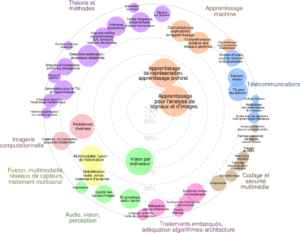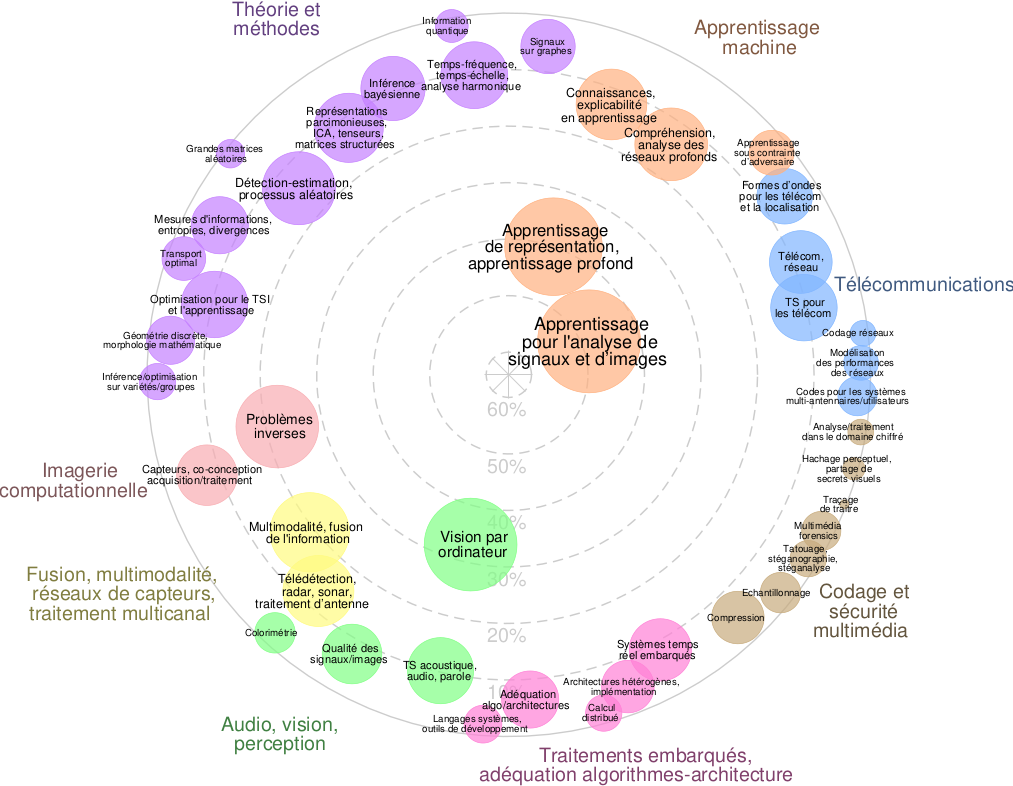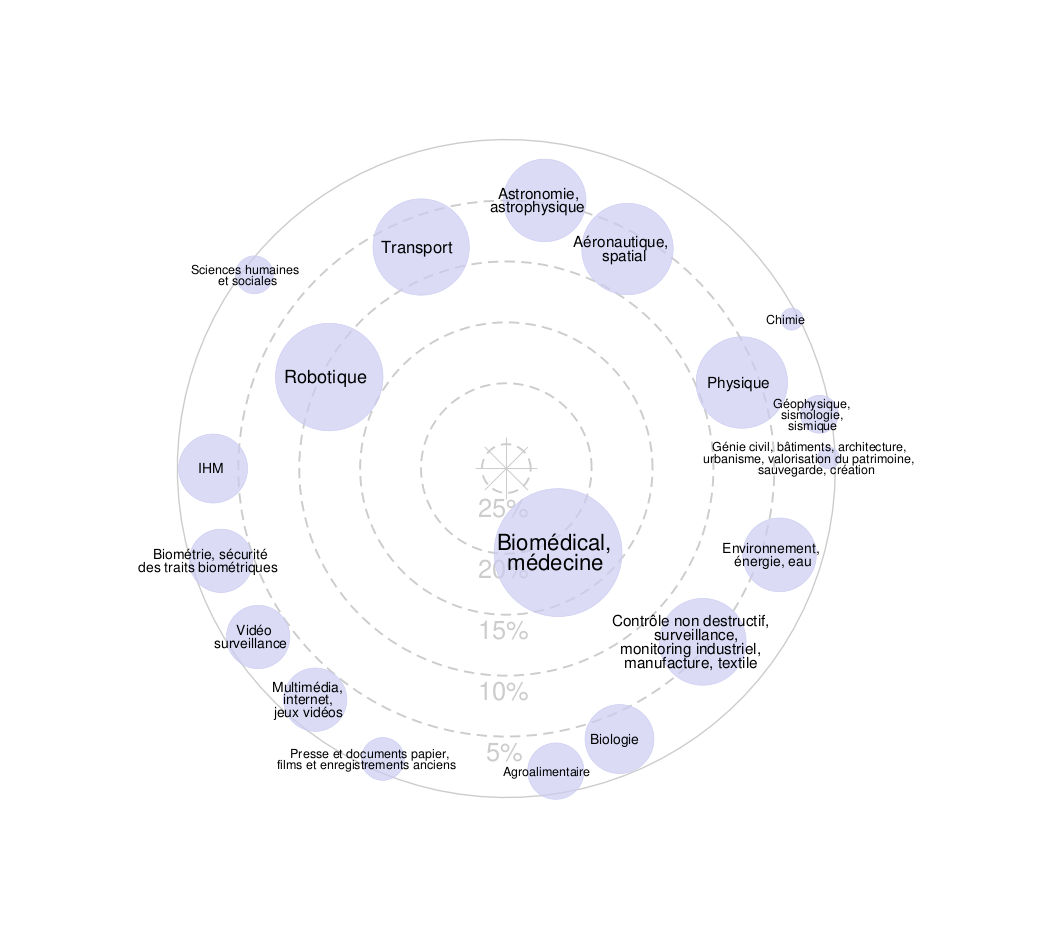Stage M2 / Ingénieur
Annonce complète : https://www.creatis.insa-lyon.fr/site/fr/node/47662
Leveraging matrix-variate distributions for ultrasound imaging
Context
Cardiovascular diseases cause more than half of all deaths across Europe and around one-third globally. It is thus crucial to develop diagnostic tools to improve how patients with these diseases are cared for. This internship project aims to quantify the cardiac muscle tissue structure using ultrasound imaging. Cardiac diffusion magnetic resonance imaging (MRI) is the only non-invasive clinical imaging modality that allows the extraction of local tissue anisotropy of the cardiac muscle. However, diffusion MRI is quite complex: it is costly, takes a lot of time and one has to remove heart movements [1]. We will investigate ultrasound imaging, which might offer a simpler alternative.
Ultrasound imaging
Ultrasound is composed of sound waves with frequencies greater than 20KHz. Images are created by sending ultrasound pulses into tissues. The ultrasound pulses echo off tissues with different properties and are returned to sensors. An image is then constructed from the recordings. In the context of this internship, we are interested in a 3D ultrasound imaging technique developed in CREATIS laboratory [2]. A 2D matrix probe, where the ultrasound sensors are physically placed on a 32×32 grid, is used to acquire data. Unfortunately, despite research efforts, the classical post-processing strategy did not feature the expected performance to estimate anisotropy accurately. Obtaining anisotropy currently involves estimating ultrasound coherence, which relies on estimating some sample covariance matrix [3].
The estimated covariance is rather large: ultrasound sensors are vectorized, and the resulting covariances are 1024×1024. However, only a few temporal samples are available, which leads to an inaccurate estimation. These inaccurately estimated covariance matrices are then leveraged to estimate anisotropy. Here, we propose to add some structure to the covariance estimation process to improve accuracy. In particular, considering the grid structure of ultrasound sensors will be leveraged. To do so, we will employ matrix-variate distributions.
Matrix-variate elliptical distributions
A random matrix X ∈ Rp×n is said to follow a centered matrix-variate elliptical distribution and can be specifically defined as a natural extension of usual multivariate elliptical distributions; see e.g., [5]. The maximum likelihood estimator is well known when considering the Gaussian density generator. However, in the general case, to the best of our knowledge, no practical algorithm to obtain the maximum likelihood estimator has been derived. Non-Gaussian distributions are appealing because they better account for noise and outliers (thanks to their heavier tail).
Internship work plan
This internship contains two different tasks. The main one involves implementing a pipeline in Python for ultrasound imaging analysis using existing data to perform coherence imaging. Such a pipeline will be released on a dedicated git repertory. The second one is more methodological: it involves deriving maximum likelihood estimators of matrix-variate elliptical distributions and finding the right way to exploit them for anisotropy estimation.
Ultrasound imaging analysis pipeline
To compare various covariance estimators in the context of local anisotropy estimation, developing a framework to measure performance on synthetic and in vivo data is necessary. Inspired by the benchmarking platform MOABB (Mother Of All BCI Benchmarks) [6], a Python open-source framework will be implemented to evaluate the quality of the various estimators. First, synthetic data will be generated to have data with the groundtruth. This simulation work was partially achieved in CREATIS during a Master’s internship. In addition, real data will be added. Covariance estimation In this task, we will first derive the maximum likelihood estimator of matrixvariate elliptical distributions with probability density function (1). The solution to the multivariate case is not known in closed form, so we will rely on an iterative procedure to estimate it. As in [7], where the maximum likelihood estimator of some specific matrix-variate distribution is derived (Elliptical Wishart distribution), we will resort on Riemannian optimization on the manifold of symmetric positive definite matrices to obtain an efficient algorithm. The other challenge in this task is to determine how to model our covariance estimation problem so that it adequately fits the ultrasound data at hand.
General information
- The internship will take place in CREATIS, Campus la Doua. Some displacements are planned to Laboratoire Signaux et Systèmes (L2S), CentraleSupélec, CNRS, Univ. Paris-Saclay.
- Supervision: Fran¸cois Varray (MCF-HDR) and Adrian Basarab (Professor) at CREATIS, Univ. Claude Bernard Lyon 1 in close relation with Florent Bouchard (L2S, CR CNRS) and Nora Ouzir (CVN, MCF CentraleSupélec).
- Profile/Skills: Student from a top engineering school or university specializing in signal processing and/or applied mathematics.
- Keywords: Signal processing, applied mathematics, signal statistics
- Start and duration of the internship: as soon as possible for 6 months.
- A PhD continuation could be envisaged thanks to the ANR DELTA project, accepted in 2024.
How to apply
Send CV + cover letter + M1/M2 or engineering school transcripts to:
- François Varray, Associate Professor, francois.varray@creatis.insa-lyon.fr
- Adrian Basarab, Professor, adrian.basarab@creatis.insa-lyon.fr
- Florent Bouchard, CNRS researcher, florent.bouchard@centralesupelec.fr
References
[1] Hongjiang Wei, Magalie Viallon, Benedicte MA Delattre, Kevin Moulin, Feng Yang, Pierre Croisille, and Yuemin Zhu. Free-breathing diffusion tensor imaging and tractography of the human heart in healthy volunteers using wavelet-based image fusion. IEEE transactions on medical imaging, 34(1):306–316, 2014.
[2] Emeline Turquin, Lorena Petrusca, Olivier Bernard, Magalie Viallon, Hervé Liebgott, and Fran¸cois Varray. Local orientation imaging for tissue structure using ultrasound imaging. IRBM, 38(5):298–303, 2017.
[3] Yuanguo Wang, Chichao Zheng, Mingzhou Liu, and Hu Peng. Covariance matrix-based statistical beamforming for medical ultrasound imaging. IEEE Transactions on Ultrasonics, Ferroelectrics, and Frequency Control, 69(1):208–221, 2021.
[4] Arjun K Gupta and Daya K Nagar. Matrix variate distributions. Chapman and Hall/CRC, 2018.
[5] Esa Ollila, David E Tyler, Visa Koivunen, and H Vincent Poor. Complex elliptically symmetric distributions: Survey, new results and applications. IEEE Transactions on signal processing, 60(11):5597–5625, 2012.
[6] Bruno Aristimunha, Igor Carrara, Pierre Guetschel, Sara Sedlar, Pedro Rodrigues, Jan Sosulski, Divyesh Narayanan, Erik Bjareholt, Quentin Barthelemy, Robin Tibor Schirrmeister, Emmanuel Kalunga, Ludovic Darmet, Gregoire Cattan, Ali Abdul Hussain, Ramiro Gatti, Vladislav Goncharenko, Jordy Thielen, Thomas Moreau, Yannick Roy, Vinay Jayaram, Alexandre Barachant, and Sylvain Chevallier. Mother of all BCI Benchmarks, 2023.
[7] Imen Ayadi, Florent Bouchard, and Frédéric Pascal. Elliptical Wishart distribution: maximum likelihood estimator from information geometry. In IEEE International Conference on Acoustics, Speech and Signal Processing (ICASSP), pages 1–5. IEEE, 2023.





